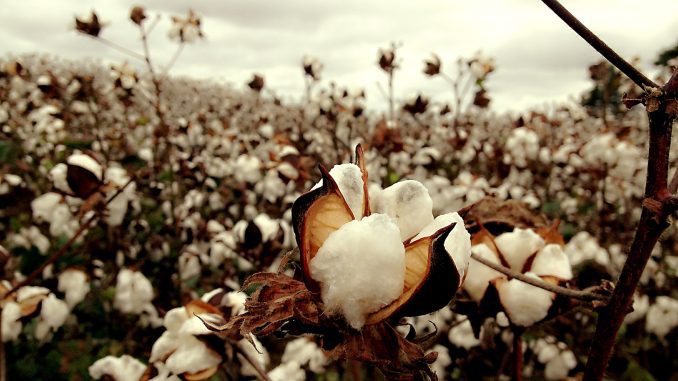
The boll weevil is not much to look at a grayish, small beetle with an impressively long snout. But this beetle’s hunger for cotton was powerful enough to forge an unprecedented partnership between farmers, legislators and scientists. And that partnership showed how much can be accomplished when scientists and farmers work together.Boll weevils entered the U.S. from Mexico in the late 1800s, when they were first spotted in Texas. By the 1920s they had spread through all of the major cotton-producing areas in the country. The scope of the damage was breathtaking, as were the control efforts thrown at this insect. At one time, one-third of the insecticide used in the U.S. was used to combat boll weevils.In 1903, the chief of the U.S. Department of Agriculture testified before Congress that the insect’s outbreaks were a “wave of evil,” and that afflicted areas in Mexico had abandoned cotton production altogether. Indeed, many scholars agree that the impact was so great on the rural South’s cotton-dependent economy that it was one of the causes of the “Great Migration,” when African-Americans moved en masse to the northern U.S. during the early 1900s.Despite the arrival of the boll weevil, cotton production grew in the U.S. because the price of cotton increased as the boll weevil ran some cotton growers out of business. Cotton production moved in advance of the weevil, creating a boom in cotton plantings in weevil-free areas. But as the cotton spread, so did the boll weevil costing cotton growers billions in revenue.Declaring war on the weevilIn 1958, the National Cotton Council of America unanimously agreed, for the first time ever, on a piece of farm legislation. That legislation included a call for more cotton research and the boll weevil to be eliminated.This was an unusual step for many reasons. First, efforts had been made to eradicate insects in livestock before, but no one had ever tried it with a crop pest. Second, the high cost would require the support of the federal government. Third, there was not yet a proven way to eradicate the insect. Finally, once eradication began, the eradication process would become a common resource. Because of this, cooperation would be vital, given that there would be a temptation for individuals, or whole regions, to get a free ride, relying on the contributions of their neighbors to the eradication effort. Mandatory farmer participation was a must. One by one, each of the challenges were addressed.Insect eradication was not an entirely new concept. The promoter of eradication was a USDA Agricultural Research Service scientist named Edward Knipling, who pioneered an eradication technique for the screwworm, a damaging livestock pest. The sterile insect technique relies on flooding the environment with lots of sterile males. Those males then mate with females, but don’t produce any offspring. Unfortunately, the sterile insect technique in the weevil population failed. One million sterile boll weevil males were released in a trial. But the sterile males couldn’t compete with their virile wild counterparts and the trial was unsuccessful.Congress funded laboratories in many states to create new tools for the eradication effort. The researchers faced a significant challenge up front. They knew that for eradication to be successful there had to be a very effective method of controlling boll weevils one with a success rate of close to 100 percent. And that would require a significant leap over the available control techniques.During the 1950s, controlling boll weevil infestations required multiple applications of very harsh and toxic insecticides. But a separate scientific advance was just around the corner.New weaponsIn the 1960s, researchers were just beginning to understand the importance of insect pheromones, the chemicals produced by insect species that change behavior of other individuals in the species. USDA scientists discovered the sex attractant pheromones of the boll weevil the combination of chemicals that allowed male boll weevils to find female boll weevils. These researchers were able to perfect a synthetic attractant pheromone blend, creating a lure that could be used to trap the amorous boll weevils. This advance would prove to be the linchpin for successful eradication, as weevils could be attracted, trapped and monitored.Another major breakthrough was a new technique of making multiple insecticide applications at short intervals during the autumn, reducing the last reproductive generation of weevils that might survive the winter. This method of control increased success from 85-90 percent control to 98-99 percent.The combination of the pheromone traps and autumn insecticide treatments meant that, given cooperation on an area-wide basis, the boll weevil might be eradicated. Plus, the pheromone traps could also be used to confirm whether eradication efforts were successful. This one-two punch was tested in a pilot program in Alabama, Mississippi and Louisiana during the early 1970s. The program couldn’t prove conclusively that the method would eradicate boll weevils, but there was enough data to attempt a much larger field trial, including ones in North Carolina and Virginia.The federal government came through with enough funding to support 50 percent of the trial, while the state of North Carolina agreed to pick up another 25 percent of the cost. North Carolina’s cotton growers agreed to fund the remaining 25 percent. Meanwhile, a new insecticide had become available, diflubenzuron, which proved to make the eradication even more successful.After three years, the method proved so successful that only one weevil was trapped in the North Carolina/Virginia eradication area and that weevil was thought to be left over in a contaminated trap that hadn’t been cleaned properly. By 2009, the boll weevil was declared eradicated from all U.S. cotton-producing states except Texas, the nation’s largest cotton producer.A fragile victoryWhich brings us to 2017. Eradication efforts have been stalled at the Texas-Mexico border, largely due to the instability created by illegal drug trafficking. That instability has effectively made large cotton farms in Mexico inaccessible for treatment, creating a welcoming habitat for boll weevil populations to rebound. Another problem in Mexico is the presence of non-cotton plant species that can host boll weevil. As a result, there is a continuing battle to keep boll weevils in check in the Lower Rio Grande Valley of Texas, funded by an ongoing annual assessment from cotton-producing states, which is aimed at preventing and tracking the spread of boll weevil populations.But this story also highlights the fact that the boll weevil has been largely conquered in the U.S., thanks to cooperation among growers, scientists and government. A boll weevil has not been captured in a pheromone trap in the South in more than 14 years. The investments made by government and the industry continue to pay dividends across the South in the form of new projects, which now tackle today’s native and invasive insects. No one wants to fight another hundred-year war with a plant pest.Dominic Reisig is an associate professor of entomology and plant pathology at NC State.



